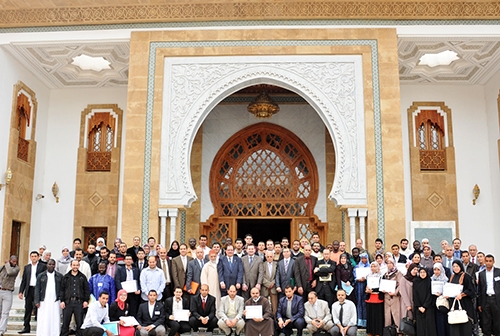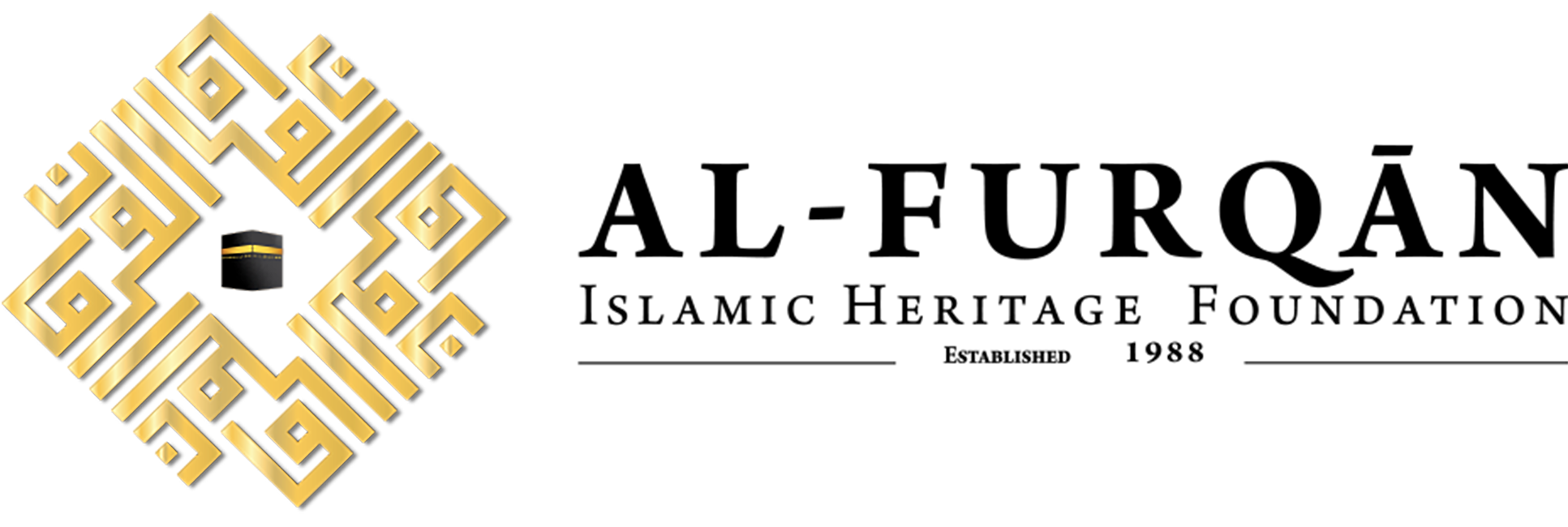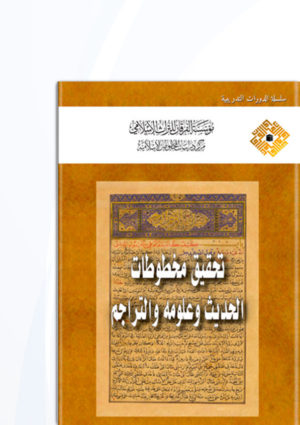The Centre for the Study of Islamic Manuscripts at Al-Furqān Islamic Heritage Foundation, in collaboration with Dar al-Ḥadīth Al-Hassania Institute of the Ministry of Awqaf in Morocco organised a training course on the critical editing of Islamic manuscripts under the title “Editing Manuscripts in the Field of Ḥadīth and its Sciences and Biographies”.
The training course took place from the 2nd to the 8th of March 2014, at the Dar al-Ḥadīth Al-Hassania Institute headquarters in Rabat, and was designed for Ph.D. and MA students at the Moroccan universities as well as specialists in manuscripts studies from other Arab countries.
The course consisted of four lectures a day, two in the morning and two in the evening. A total of 19 lectures in all were delivered by specialist professors in this field, in addition to eight workshops on manuscripts of Ḥadīth, biographies, narrators, catalogues and bibliographies.
More than 1,300 candidates applied to this course, only 82 of whom were accepted.
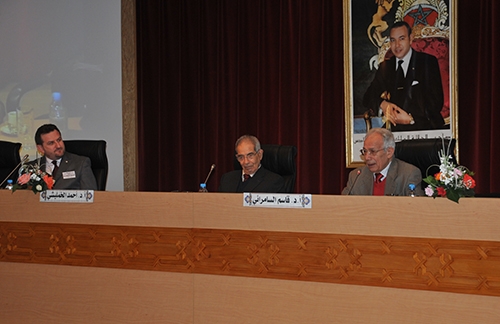
On the first day, the opening session began with Qurʾān recitation; then a welcome speech by Dr. Ahmad al-Khamlichi, the Director of Dar Al-Ḥadīth Al-Hassania, followed by another speech by Mr Sali Shahsivari, the Director of Al-Furqān Islamic Heritage Foundation, and concluded with a speech by Prof. Qasim al-Samarrai, on behalf of the course lecturers.
After the inauguration ceremony, which was held in honour of the guests and participants, the first lecture was given by Dr. Muhammad Bencherifah titled: “Qadi ‘Iyad: Founder of the Rules of Editing Books on Ḥadīth and Biographies in Al-Maghrib”, in which he shed light on the life of Qadi ‘Iyad and his contribution to culture in general, as well as establishing the rules of editing in the Islamic West.
The following lecture was delivered by Dr. Ahmed Chauquie Binebine, the Director of the Al-Hassania Library, titled “The Critical Editing: Difficulties and Problems”, in which he elaborated on the difficulties, obstacles and complicated problems which manuscript scholars face while critically editing their texts.
Next was Dr. Al-Chahid Al-Boucheikhi’s lecture, titled: “The Importance of the Text Editing in the Arab Islamic Heritage”, in which he thoroughly assessed this discipline, considering the heritage as the body of the nation and its safety valve, and the basis of the renewal of its past glory.
On the second day, the sessions focused on books of biographies and the mashikhāt, where Dr. Qasim al-Samarrai, expert in codicology, delivered his lecture on editing manuscripts on the mashikhāt and related problems, using Mashikhāt Ibn al-‘Aquli as a case study. The lecturer dealt with the evolution of the discipline, then its methodologies and means, the status of the books of this genre and the mistakes existing in them due to some editors’ incompetence in Islamic culture and in science of Ḥadīth narrators in particular.
Then, Dr. Saeed Bel‘azzi, in his lecture “Critical Editing of Biographies: Between the Ideal Approach and Reality”, discussed the pre-conditions that should be fulfilled by the person who works on biographical books, in order to enable him to produce it in a format compatible with the standard of the Ummah, to whom this heritage belongs, in terms of authenticity and preciseness.
The previous lecture was followed by Dr. Badr Al-‘Imrani’s lecture titled: “Dealing with Misreading and Distortion in Editing Biographical Works: Rules and Examples”, in which he highlighted the contribution of the Ḥadīth scholars in addressing this phenomenon, who put rules and principles to counter its consequences. Then, he presented some examples from the published works, where the editors violated such rules, thus producing distorted editions.
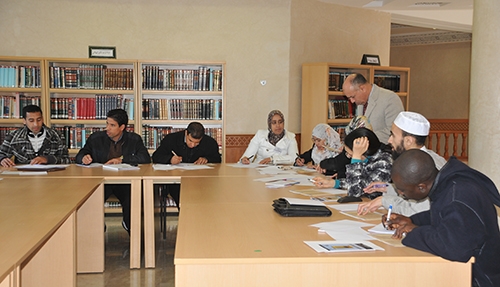
Both the third and sixth day were devoted to the workshops. Students were divided into four groups. Each group was supervised by a trainer from the Hassania Library. The aim of the workshops was the practical application of the theories provided in the lectures, since the purpose of the course was to combine both theory and practice.
Workshops were modelled on the following format: examples of manuscripts on biographies, narrators, catalogues and bibliographies; the methodology of reading and editing; practical examples from Ḥadīth manuscripts in Dar al-Ḥadīth Al-Hassania; authentication and commentary; examples of manuscripts biographies, narrators, catalogues and bibliographies; methodology of biography writing.Dr Muhammad Nasiri’s lecture was titled: “Characteristics of Ḥadīth Manuscripts and Examples of its Editing Mistakes”, in which he emphasized the specificity that characterizes the books of Ḥadīth, and the mistakes committed by those who didn’t take into account this specificity.
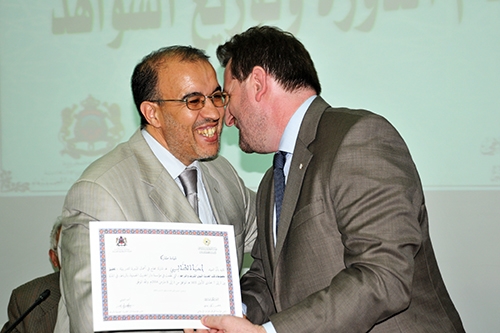
On the fourth day, the programme focused on the importance of establishing the Ḥadīth text. It began with Dr. Mustafa Alzakkaf’s lecture on “Variant Narrations in Ḥadīth Manuscript: Causes and Rules for Dealing with Them”, where he underlined the different versions of the text, transmitted by various narrators from the author, and emphasised the need of the utmost diligence in this matter in order to avoid any inaccuracies.
This was followed by Dr. Aziz Al-Khatib’s lecture on “Establishing the Text by Ḥadīth Scholars: ‘Collation’ as a Case Model”, in which he focused on this characteristic that distinguished the Islamic written heritage and explained its significance.
Then Dr Bouchta Al-Zafzoufi gave his presentation titled “Ḥadīth Heritage between the Errors of Scribes and Illusions of Editors”. He gave examples of copyists’ mistakes, and exhorting all to be alert to them. He also introduced examples of text editors’ mistakes and how such mistakes affected their work.
Friday’s main theme was: Manuscript text, format, traditions and extensions. It was addressed as follows:
Dr Ibrahim Azoug’s session on “Types of Symbols in the Arabic Manuscripts”, followed by Dr. Hassan Al-Uthman’s lecture on “Text Extensions: Their Types, Categories and Divisions, and Their Unique Outcome”. It was prepared and delivered on his behalf by Dr. Saeed Bel‘azzi.
The proceedings of the training course culminated with workshops on Saturday, followed by an open discussion with the lecturers.
The closing session included short speeches by the representatives of the two institutions, lecturers and students, who strongly petitioned the Foundation to offer such courses more frequently, in order to fulfil the urgent need for it, since it proved to be fruitful, achieved its designated goals and was meticulously organised.
They also emphasized the need for increasing the practical elements in relation to the theoretical. Of particular note was the great enthusiasm of the students, and their full interaction with lectures, and the many questions and criticisms which showed a deep interaction with lectures and workshops.The training course concluded with the distribution of certificates to the researchers, participants and organisers.
